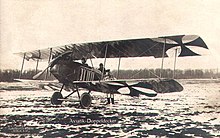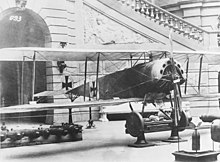Oswald Boelcke
Flying the first true fighters, Boelcke, Max Immelmann, and several other early aces began shooting down enemy airplanes.
His innovative turn of mind codified his combat experiences into the first manual of fighter tactics distributed to an air force, the Dicta Boelcke.
During September and October 1916, Boelcke scored 21 more victories while commanding Jagdstaffel 2, maintaining his position as the world's highest-scoring ace.
[1][2] His family name was originally spelt Bölcke, but Oswald and his elder brother Wilhelm (1886–1954) dispensed with the umlaut and adopted the Latin spelling in place of the German.
Under this influence, while in the third or fourth form, ten-year-old Boelcke wrote a personal letter to Kaiser Wilhelm requesting an appointment to military school.
As the advent of spring lengthened the days, he took advantage of his early class dismissal to spend the rest of his daylight hours watching airplanes at a nearby airfield.
On 31 August, he connived his way into joining his older brother Wilhelm at Feldflieger Abteilung 13 (Field Flyer Detachment 13).
[a] The brothers soon compiled a record of flying longer missions at more frequent intervals than the other aircrews, causing some resentment within the unit.
In late March, matters came to a head when the brothers refused to fly separately and jumped the chain of command to complain but, in April, they were parted.
As Wilhelm returned to Germany, Oswald was posted to Feldflieger Abteilung 62 (Field Flyer Detachment 62) in La Brayelle, Douai, France on 25 April.
His new assignment brought him friendship with Max Immelmann, a fellow citizen of the Prussian Province of Saxony serving in the unit.
[citation needed] When Roland Garros, Eugène Gilbert and Adolphe Pégoud managed to score the first aerial victories, they caught the public imagination.
[b] To an audience overwhelmed by a war of enormous armies and geographic complexity, simple stories of lone heroes had great appeal.
German propagandists took advantage of this by supplying press releases to newspapers and magazines, encouraging printing of postcards, and filming of popular aviators.
[27][28] After two unsuccessful combats in two-seated reconnaissance craft,[citation needed] Boelcke scored his first accredited victory on 4 July 1915, after 30 minutes of angling about to afford his observer with fields of fire.
While watching French locals fishing from a high pier jutting into a canal, Boelcke saw a teen boy topple in and sink.
Boelcke connected a front-line observation post to the Sivry airfield and established the first tactical air direction center.
[63] On 3 March 1916, Boelcke was ordered to evaluate a new Eindecker prototype: his report pointed out shortcomings like inaccurately mounted guns and the limitations of its rotary engine.
[67] By this time, the obsolescent Fokker E.III was being replaced by newer Halberstadt D.II single-gun and twin-gun Albatros D.I biplane fighters, both types fitted with synchronized guns.
[68][69] The ace race continued, although Buddecke lost ground and was no longer a contender due to problems verifying some of his victories in Turkey.
[70] When Boelcke shot down two enemy airplanes on 21 May 1916, the emperor disregarded army regulations prohibiting promotion to Hauptmann until age 30.
Boelcke was promoted to the rank ten days past his 25th birthday, making him the youngest captain in the German military.
Making his rounds of the Turkish flying units supported by the German Military Mission, Boelcke again met his friend Hans Joachim Buddecke.
With more powerful engines, the new arrivals were faster, climbed more quickly to a higher ceiling, and carried two synchronized nose machine guns instead of one.
On 8 October, General Erich Ludendorff reorganized the makeshift Fliegertruppe into the Luftstreitkräfte and appointed Generalleutnant Ernst von Hoeppner to the new post of Chief of Field Aviation.
As the fabric tore away, the wing lost lift, and the aircraft spiralled down to glide into an impact, near a German artillery battery near Bapaume.
Another wreath of British origin had been air dropped by the Royal Flying Corps; it read "To the memory of Captain Boelcke, our brave and chivalrous opponent".
[102] When the train arrived in Dessau the next day, Boelcke was taken to his home church, Saint John's and laid out before the altar, attended by an honor guard of decorated sergeant pilots.
The concentration of fighter airplanes into squadrons gained Germany air supremacy on the Western Front, and was the basis for their wartime successes.
[108] Four of its aces became generals during World War II – Gerhard Bassenge, Ernst Bormann, Hermann Frommherz, and Otto Höhne.









